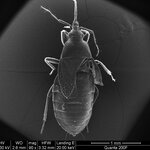Ecology & Zoology
More than 150 years ago, immigrant Chinese fishermen launched sampans into the chilly waters of Monterey Bay to capture squid. The Bay also lured fishermen from Sicily and other Mediterranean countries, who brought round-haul nets to fish for sardines.
This was the beginning of the largest fishery in the western hemisphere – California’s famed ‘wetfish’ industry, named for the fish that were canned wet from the sea, that has remained imprinted on our collective conscience by writers like John Steinbeck.
Who doesn’t remember Cannery Row?
It was the plentiful schools of fish…

If bugs have their own Tori Amos, she is likely writing about sexual conflict and how reproduction exists at all given that it can be so costly, especially to females. One aspect of this conflict concerns how females respond to increased mating events that are of more benefit to males than to themselves.
New work discusses how some males, instead of mating conventionally, take the awkward step of piercing and penetrating their mate through her body wall. This mating behavior is known as traumatic insemination and it potentially comes at a great physiological cost to the female.…

Giant flea-like animals, possibly the oldest of their type ever discovered, bit creatures much larger than they are 165 million years ago - and lived to talk about it.These flea-like animals, were similar to modern fleas but 10 times the size of a flea you might find crawling on your family dog – with a proboscis and an extra-painful bite to match. Dinosaurs were likely not amused.Pseudopulex jurassicus and Pseudopulex magnus had bodies that were more flat, like a bedbug or tick, and long claws that could reach over scales on the skin of dinosaurs so they could hold onto them tightly…
I love four things about this story.
First: there is an All England squid catching championship. Did you know that? I did not know that.
Second: the weather this year was so bad the competitors were almost completely skunked. Almost.
Third: This is the cutest trophy shot I have EVER SEEN.
Photo: Robin Howard/BNPS
According to The Telegraph,
Reigning champion Davide Thambiturai spotted a tiny specimen on his squid jig lure just as he was about to cast off again. Davide, who won last year's event with a 61cm squid, took a photo and measured it at just a third of an inch long before…

If a species´ reproductive strategy is evolutionarily adapted to the environmental constraints encountered by that species in its natural habitat, such as availability of food resources and predictability of the environment, and the aim generally is to produce the largest possible number of surviving offspring under particular conditions, then common dormice are defying that just a little.
Researchers observed two peaks of reproduction within the active season in a wild dormouse population in Lithuania. About one third of the litters were born early in the year (June), but the majority were…

Gobies are the little fish you may have seen under the pier or swimming around your feet in salty water if you’ve visited the coasts of Western Europe. These seemingly boring brownish fish live a hectic life, lasting only one year. Up close, the gobies are as glamorous as gold fish, in orange fish frocks and shiny bellies full of eggs.
Secretly, they are the stars of “Fishteria Lane.” As the mating season draws to an end, guys drop dead by the hour, making goby girls go all out in their hunt for a mate to father their offspring.
There's no time to be coy.
Two-spotted gobies are tiny…

I may have mentioned before that squid fishermen of the Falkland Islands go after two very different species: Illex argentinus, the shortfin squid, an open-ocean animal that migrates between Falkland and Argentinian waters, and Loligo gahi, the Patagonian squid, which is present in both Falkland and Argentinian waters but doesn't move much between the two.
As a result of these mobile versus sedentary habits, the two squid have different management needs. Since the Illex resource is shared between two nations, decisions made by one necessarily affect the other. It…

A small marine worm, Olavius algarvensis, is faced with a scarce food supply in the sandy sediments it lives in off the coast of Elba, so it must deal with a highly poisonous menu: it lives on carbon monoxide and hydrogen sulfide.
O. algarvensis can thrive on these poisons thanks to millions of symbiotic bacteria that live under its skin. The bacteria use the energy from carbon monoxide and hydrogen sulphide to produce food for the worm, just like plants do by fixing carbon dioxide into carbohydrates - but instead of using light energy from the sun, the symbionts use the energy from chemical…

It's called Knowledge and it's a short story by John Frizell in Nature. Did you know that Nature publishes short stories, one at the back of every issue? They do!
No human could have grasped the squid's name. Human eyes could not distinguish the differences in shades of colour or register the intervals at which they changed to define the unique pattern that was his name. The squid was concentrating hard because he was holding two conversations at once, one deliberately misleading, the other closer to the truth, as he glided through the deep ocean, his mantle pulsing gently, powering him with…
In Moby Dick, Melville scoffs that “fine ladies and gentlemen should regale themselves with an essence found in the inglorious bowels of a sick whale.” Following the example of the Ancient Egyptians and Chinese, the fragrance industry has employed this essence, called ambergris, in perfume making for years.
But here’s the hitch: the stuff fetches up to $20,000 per kilogram, yet ambergris is nothing but vomit from endangered sperm whales. When the animals consume sharp objects like shells or squid beaks, their guts coat the hazardous items in a sticky substance to protect their organs. The…